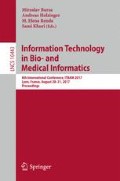Abstract
In this work, we study the use of convolutional neural networks for biomedical signal processing. Convolutional neural networks show promising results for classifying images when compared to traditional multilayer perceptron, as the latter do not take spatial structure of the data into an account.
Cardiotocography (CTG) is a monitoring of fetal heart rate (FHR) and uterine contractions (UC) used by obstetricians to assess fetal well-being. Because of the complexity of FHR dynamics, regulated by several neurological feedback loops, the visual inspection of FHR remains a difficult task. The application of most guidelines often result in significant inter-and intra-observer variability.
Convolutional neural network (CNN, or ConvNet) is inspired by the organization of the animal visual cortex.
In the paper we are applying continuous wavelet transform (CWT) to the UC and FHR signals with different levels of time/frequency detail parameter and in two different resolutions. The output 2D structures are fed to convolutional neural network (we are using Tensorflow framework [1]) and we are minimizing the cross entropy function.
On the testing dataset (with pH threshold at 7.15) we have achieved the accuracy of 94.1% which is a promising result that needs to be further studied.
Access this chapter
Tax calculation will be finalised at checkout
Purchases are for personal use only
Notes
- 1.
Moreover, the results often differ by location and/or country. You can find more information in the works of Spilka et al., i.e. [12].
- 2.
The open-access database [4] is freely available at the following link: http://www.physionet.org/physiobank/database/ctu-uhb-ctgdb/. We therefore encourage other researchers to take advantage of this free database available.
- 3.
Short-Term FFT.
- 4.
The common minimal lengtht of all recordings (lenght of the shortest recording). We are aware that this part of the signal might be affected by the decision of the physician and thus contain information about the outcome and subsequently bias this research.
- 5.
We have omitted the record no 4004 as it caused an unspecified error when processed by FFT.
- 6.
tf.train.exponential_decay().
- 7.
tf.train.AdamOptimizer().
References
Abadi, M., Agarwal, A., Barham, P., Brevdo, E., Chen, Z., Citro, C., Corrado, G.S., Davis, A., Dean, J., Devin, M., Ghemawat, S., Goodfellow, I., Harp, A., Irving, G., Isard, M., Jia, Y., Jozefowicz, R., Kaiser, L., Kudlur, M., Levenberg, J., Mané, D., Monga, R., Moore, S., Murray, D., Olah, C., Schuster, M., Shlens, J., Steiner, B., Sutskever, I., Talwar, K., Tucker, P., Vanhoucke, V., Vasudevan, V., Viégas, F., Vinyals, O., Warden, P., Wattenberg, M., Wicke, M., Yu, Y., Zheng, X.: TensorFlow: Large-scale machine learning on heterogeneous systems (2015). http://tensorflow.org/, softwareavailablefromtensorflow.org
Bernardino, A., Santos-Victor, J.: A real-time gabor primal sketch for visual attention. In: Marques, J.S., Pérez de la Blanca, N., Pina, P. (eds.) IbPRIA 2005. LNCS, vol. 3522, pp. 335–342. Springer, Heidelberg (2005). doi:10.1007/11492429_41
Bursa, M., Lhotska, L., Chudacek, V., Spilka, J., Janku, P., Hruban, L.: Information retrieval from hospital information system: Increasing effectivity using swarm intelligence. J. Appl. Logic 13(2, Pt. A), 126–137 (2015). http://www.sciencedirect.com/science/article/pii/S1570868314000809, sI: SOCO12
Chudacek, V., Spilka, J., Bursa, M., Janku, P., Hruban, L., Huptych, M., Lhotska, L.: Open access intrapartum ctg database. BMC Pregnancy Childbirth 14, 16 (2014)
Chudáček, V., Spilka, J., Huptych, M., Lhotská, L.: Linear and non-linear features for intrapartum cardiotocography evaluation. Computing in Cardiology 2010 Preprints. IEEE, New Jersey (2015)
Doret, M., Spilka, J., Chudáček, V., Gonçalves, P., Abry, P.: Fractal Analysis and Hurst Parameter for intrapartum fetal heart rate variability analysis: A versatile alternative to Frequency bands and LF/HF ratio. PLoS ONE 10(8), e0136661 (2015). http://dx.doi.org/10.1371%2Fjournal.pone.0136661
Goldberger, A.L., Amaral, L.A.N., Glass, L., Hausdorff, J.M., Ivanov, P.C., Mark, R.G., Mietus, J.E., Moody, G.B., Peng, C.K., Stanley, H.E.: PhysioBank, PhysioToolkit, and PhysioNet: Components of a new research resource for complex physiologic signals. Circulation 101(23), e215–e220 (2000). Circulation Electronic Pages: http://circ.ahajournals.org/cgi/content/full/101/23/e215
Hruban, L., Spilka, J., Chudáček, V., Janků, P., Huptych, M., Burša, M., Hudec, A., Kacerovský, M., Koucký, M., Procházka, M., Korečko, V., Seget’a, J., Šimetka, O., Mchurová, A., Lhotská, L.: Agreement on intrapartum cardiotocogram recordings between expert obstetricians. J. Eval. Clin. Pract., May 2015. http://dx.doi.org/10.1111/jep.12368
Huser, M., Janku, P., Hudecek, R., Zbozinkova, Z., Bursa, M., Unzeitig, V., Ventruba, P.: Pelvic floor dysfunction after vaginal and cesarean delivery among singleton primiparas. Int. J. Gynecol. Obstet. 137(2), 170–173 (2017). http://dx.doi.org/10.1002/ijgo.12116
Kingma, D.P., Ba, J.: Adam: A method for stochastic optimization. CoRR abs/1412.6980 (2014). http://arxiv.org/abs/1412.6980
Spilka, J., Frecon, J., Leonarduzzi, R., Pustelnik, N., Abry, P., Doret, M.: Sparse support vector machine for intrapartum fetal heart rate classification. IEEE J. Biomed. Health Inform. 21(3), 664–671 (2017)
Spilka, J., Chudáček, V., Janků, P., Hruban, L., Burša, M., Huptych, M., Zach, L., Lhotská, L.: Analysis of obstetricians decision making on CTG recordings. J. Biomed. Inform. 51(0), 72–79 (2014). http://www.sciencedirect.com/science/article/pii/S1532046414000951
Acknowledgment
The research is supported by the project No. 15-31398A Features of Electromechanical Dyssynchrony that Predict Effect of Cardiac Resynchronization Therapy of the Agency for Health Care Research of the Czech Republic. This work has been developed in the BEAT research group https://www.ciirc.cvut.cz/research/beat with the support of University Hospital in Brno http://www.fnbrno.cz/en/. Access to computing and storage facilities owned by parties and projects contributing to the National Grid Infrastructure MetaCentrum provided under the programme Projects of Large Research, Development, and Innovations Infrastructures (CESNET LM2015042), is greatly appreciated.
Author information
Authors and Affiliations
Corresponding author
Editor information
Editors and Affiliations
Appendix: Results
Appendix: Results
Rights and permissions
Copyright information
© 2017 Springer International Publishing AG
About this paper
Cite this paper
Bursa, M., Lhotska, L. (2017). The Use of Convolutional Neural Networks in Biomedical Data Processing. In: Bursa, M., Holzinger, A., Renda, M., Khuri, S. (eds) Information Technology in Bio- and Medical Informatics. ITBAM 2017. Lecture Notes in Computer Science(), vol 10443. Springer, Cham. https://doi.org/10.1007/978-3-319-64265-9_9
Download citation
DOI: https://doi.org/10.1007/978-3-319-64265-9_9
Published:
Publisher Name: Springer, Cham
Print ISBN: 978-3-319-64264-2
Online ISBN: 978-3-319-64265-9
eBook Packages: Computer ScienceComputer Science (R0)




